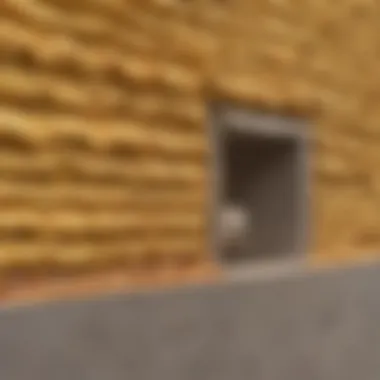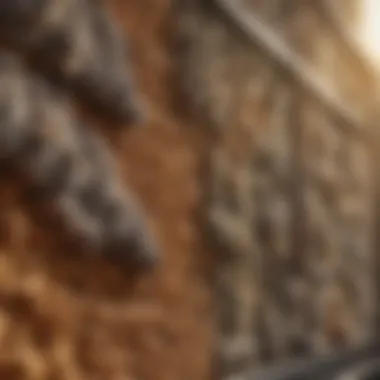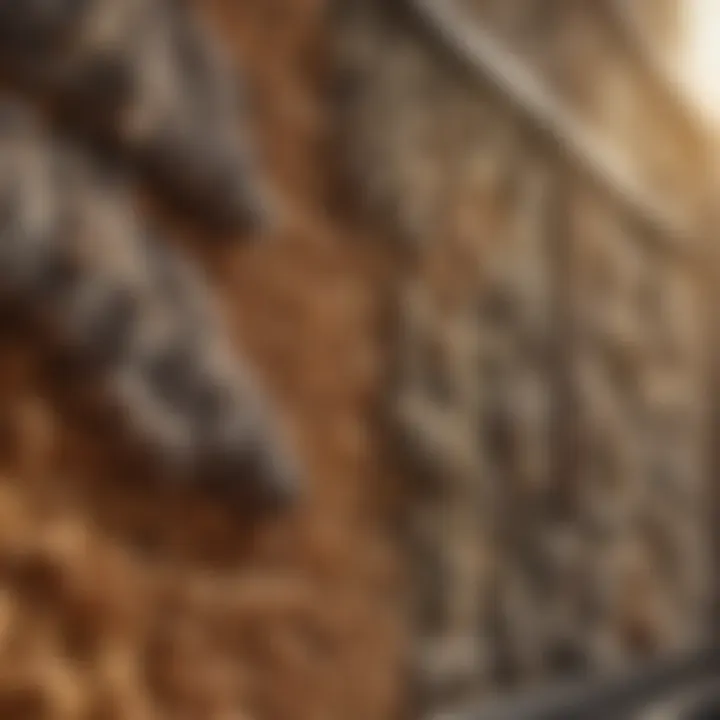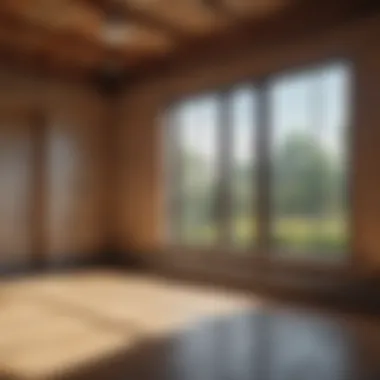Best Insulation Strategies for Effective Pest Control


Intro
In the quest for effective pest management, many homeowners overlook the crucial role insulation plays. Quality insulation not only shields against temperature fluctuations but also serves as a barrier against pest invasions. Understanding how insulation interacts with pest control strategies is vital for anyone seeking a comprehensive solution to maintaining a pest-free home.
Insulation impacts energy efficiency and indoor air quality, but its influence extends further into the realm of pest prevention. Various insulation types can deter pests, reducing their chances of finding entry points into a dwelling. Moreover, selecting the right insulation material can create a hostile environment for pests, making it hard for them to thrive. This article will delve into the synergies between insulation and pest control, guiding homeowners in making purposeful decisions that enhance both their living spaces and pest management efforts.
Understanding the Pest
In order to effectively manage pests, one must first understand their nature. This includes recognizing what pests are present and how they develop.
Identification
Identifying pests is the first step in effective control. Common household pests include ants, termites, rodents, and cockroaches. Each species has distinct features and behaviors. For example, termites are often identified by their wood-destroying habits and the presence of mud tubes. In contrast, ants may be spotted following trails to food sources. Understanding the species is crucial, as it informs how one might prevent or treat infestations.
Life Cycle
Each pest has a unique life cycle that can influence management strategies. For example, the life cycle of a cockroach includes egg, nymph, and adult stages. Knowing this cycle aids in timing interventions. If one only addresses adult pests, they may miss eggs and nymphs, leading to ongoing issues. Recognizing these phases allows more targeted treatments and preventive measures.
Pest Prevention Strategies
Preventing pests from entering a home should be the primary goal. Adequate insulation plays a significant role in this effort.
Environment Modification
Modifying the home environment can deter pests naturally. Simple actions, such as sealing cracks in walls and using weather stripping on doors, can limit entry points. Additionally, keeping landscaping tidy helps eliminate potential pest habitats. Good insulation can also significantly lower humidity levels, making the environment less inviting for many pests that thrive in damp conditions.
Physical Barriers
Physical barriers are effective in preventing pests. Insulation materials like cellulose are treated to be pest-resistant. Additionally, foam board insulation can be a robust physical barrier against rodents, making it less likely for them to chew through. By combining these materials with mesh screens on windows and doors, homeowners can enhance their defenses against invasions.
Control Methods
Once pests enter a home, control methods become necessary. Depending on the severity of the infestation, different strategies may be more suitable.
Chemical Control
Chemical control methods involve using pesticides and other substances to eliminate pests. While they can be effective, it's essential to select products labeled safe for indoor use. This is especially important for those with children or pets. Using chemical controls in conjunction with insulation strategies can bolster efforts to keep pests at bay.
Biological Control
Biological control employs natural predators to manage pest populations. For instance, introducing certain types of beneficial insects can help control aphid populations in gardens. This approach can be particularly advantageous for environmentally-conscious homeowners. Ultimately, finding a balance between chemical and biological methods can optimize pest control efforts without relying solely on harsh chemicals.
"The best pest control strategy combines prevention with effective treatment methods to ensure a lasting solution."
In summary, understanding pest behaviors, lifecycle, and prevention strategies is critical. By integrating proper insulation into these efforts, homeowners can create a healthier, more efficient living environment while significantly reducing pest risks.
Preface to Insulation and Pest Control
Insulation is a critical element in modern construction, influencing both energy efficiency and indoor environment. Understanding the connection between insulation and pest control is vital. This aspect goes beyond reducing energy costs; it also enhances the comfort of living spaces while minimizing the risks related to pest invasions. The effectiveness of insulation in these regards often shapes decisions made by homeowners and builders alike.
Understanding the Importance of Insulation
Insulation serves multiple purposes. Primarily, it acts as a barrier against heat loss or gain, maintaining a stable indoor temperature. This stability not only aids in energy conservation but also affects moisture levels within buildings. Moisture can quickly attract pests like termites and rodents, making effective insulation an indirect measure of pest prevention. Additionally, proper insulation leads to an enhanced indoor air quality by reducing drafts and preventing the infiltration of outdoor pollutants. Energy savings can be significant; homes with adequate insulation can save on heating and cooling costs, making it a valuable investment.
The Role of Insulation in Pest Management
The relationship between insulation and pest management is gaining recognition in various fields. Effective insulation helps in establishing an environment that dissuades pests from entering. Certain materials, such as spray foam insulation, can seal gaps that rodents might use as entry points. Other solutions, like cellulose insulation, may be treated with pest-repellent additives. The insulation layer can also serve as a sound barrier; reducing noise may indirectly discourage certain pests that are attracted to vibrations and disturbances. Thus, selecting the right insulation type is not just about energy efficiency but also about maintaining a pest-free home.
"Properly insulated homes provide comfort while also serving as barriers to unwanted pests."
The interplay between insulation and pest control is nuanced. Homeowners must consider factors like material choice, installation quality, and ongoing maintenance. An informed approach will yield benefits that extend from reduced bills to a healthier living environment.
Types of Insulation Materials
Understanding the different types of insulation materials is crucial for effective pest control. Each material offers unique properties that influence its ability to insulate while also deterring pests. Homeowners must navigate various choices to ensure their selection not only promotes energy efficiency but also reinforces pest management strategies.
When choosing insulation, consider factors such as thermal resistance, moisture control, and potential alignment with pest activity. Insulation can act as a barrier, not only to temperature fluctuations but also to unwanted intruders. Evaluating insulation materials in this context ensures a comprehensive approach to maintaining a pest-free environment.


Fiberglass Insulation
Fiberglass insulation is one of the most commonly used materials in residential buildings. It consists of tiny glass fibers that create a dense mat, allowing for excellent thermal resistance. This insulation is non-combustible and resistant to moisture, which helps to prevent mold growth.
Pests, such as rodents, do not nest in fiberglass insulation, making it a safe choice in terms of pest prevention. It is also relatively inexpensive and easy to install, an appealing factor for many homeowners.
However, it’s important to manage ventilation properly when using fiberglass. If air is trapped, it can create areas of condensation that might attract pests.
Foam Board Insulation
Foam board insulation provides solid thermal protection and is highly effective for foundational insulation. The material comes in rigid panels made from polystyrene or polyisocyanurate, which offer high R-values per inch. This efficient thermal barrier helps to maintain indoor temperatures while minimizing energy consumption.
Regarding pest control, foam board insulation can also deter pests. Its rigid structure makes it challenging for pests to penetrate and nest inside, notably in spaces like crawl spaces or basement walls. However, ensuring a proper fit during installation is vital to prevent gaps where pests could enter.
Spray Foam Insulation
Spray foam insulation is a versatile choice that expands on application, filling all gaps and crevices. This material offers superior thermal resistance compared to traditional options. Its ability to seal spaces tightly can dramatically reduce air leaks.
From a pest perspective, the continuous barrier created by spray foam makes it difficult for insects and rodents to find entry points. Additionally, some manufacturers add pest-repelling agents to their spray foam formulations. Still, proper installation is essential to fully realize these benefits, which may require professional assistance.
Cellulose Insulation
Cellulose insulation is made from recycled paper products treated for fire and pest resistance. It is an eco-friendly option that offers substantial thermal insulation. With a dense, packed form, cellulose can fill voids in walls effectively and reduce air leaks.
Cellulose can naturally deter pests, as the treating agents often include a borate compound that repels insects. While cellulose provides numerous advantages in terms of sustainability and pest control, moisture management is crucial; if it gets damp, it may become conducive to mold and other pests.
Mineral Wool Insulation
Mineral wool, or rock wool, is produced from natural materials and treats to be fire resistant. It is a water-repellent option that maintains its insulative properties even in damp conditions. The textured fibers create a barrier that can effectively absorb sound while also insulating.
For pest control, mineral wool's density makes it challenging for rodents to nest. Like cellulose, it has excellent moisture control properties, reducing the likelihood of attracting pests through dampness. Homeowners should consider its environmental impact and potential installation costs against its benefits.
Evaluating Insulation Effectiveness
Evaluating how effective insulation materials are is crucial for both pest control and energy efficiency in homes. Proper evaluation helps you understand not just how well insulation keeps your home warm or cool, but also its role in preventing pest invasions. Selecting the right insulation involves looking at several factors that can contribute to your overall home maintenance plan.
Thermal Resistance and Energy Efficiency
Thermal resistance, often measured in R-value, quantifies the effectiveness of insulation in resisting heat flow. Insulation that retains more heat during winter and keeps it out during summer can significantly lower energy bills. Understanding the R-value is essential for homeowners. The higher the R-value, the better the material prevents heat transfer.
Energy efficiency benefits include:
- Lower utility costs
- Enhanced comfort levels in living spaces
- Reduction in energy consumption, contributing to environmental sustainability
Using insulation with high thermal resistance can also link with pest control. For instance, pests tend to thrive in environments with fluctuating temperatures. Effective insulation stabilizes temperatures inside the home, making it less attractive to unwanted guests.
Moisture Control and Ventilation
Inadequate moisture control can lead to various issues, such as mold growth and structural damage. Excellent insulation needs to be complemented by proper ventilation systems. Moisture barriers are recommended to prevent excess humidity.
Key points to consider include:
- Placement of moisture barriers
- Use of breathable materials
- Regular checks for leaks
Proper moisture control can further discourage pests. Many bugs, for instance, thrive in damp conditions. By keeping moisture levels low through effective insulation and ventilation, you are adding another layer of defense against pest infestations.
Sound Barriers and Pest Behavior
Insulation that functions as a sound barrier can also play a role in pest behavior. Many pests respond to vibrations and noise, which can signal the presence of potential threats.
Soundproof insulation features:
- Density: Denser materials tend to absorb sound better
- Installation: Proper installation minimizes sound transmission
In preventing pests like rodents, sound barriers can deter their movement. If a structure is quiet and secure, it is less likely to attract pests searching for food or nesting sites.
A well-thought-out insulation plan plays a significant role in both energy efficiency and pest management. Choosing the right materials can change how comfortable and secure your home feels.


In summary, evaluating insulation effectiveness involves more than merely selecting what looks good. It's about integrating thermal resistance, moisture control, and soundproofing into a cohesive plan that addresses both comfort and pest prevention.
Pest Resistance Features in Insulation
Pest resistance features in insulation play a crucial role in safeguarding both residential and commercial properties from infestations. Often overlooked, insulation's ability to deter pests can have significant implications for health, maintenance, and energy efficiency. When selecting insulation, it is vital to consider materials designed specifically to resist pest infiltration. This not only helps to create a barrier against common household pests but also contributes to a healthier living environment.
Incorporating pest-resistant insulation can diminish the likelihood of infestations, which can lead to costly repairs and pest control services. Furthermore, pest-resistant insulation contributes to energy efficiency by sealing gaps and areas where pests may enter, thus maintaining a stable indoor climate. Underestimating the importance of these features can lead to long-term consequences, including health concerns due to pest droppings and contamination in the home.
Insect-Resistant Insulation Options
Choosing insect-resistant insulation is an essential step in preventing pest issues. Several insulation products offer built-in properties to repel pests such as ants, termites, and cockroaches.
- Foam Board Insulation:
Typically made from polystyrene or polyisocyanurate, foam board insulation provides a solid barrier that is less appealing to insects. Its surface is smooth, minimizing nesting opportunities for pests. - Spray Foam Insulation:
This type expands to seal gaps and cracks, leaving fewer entry points for insects. Additionally, its composition often deters pests due to its moisture resistance, as many pests thrive in damp conditions. - Mineral Wool Insulation:
Also known as rock wool, mineral wool is another option that is resistant to insects. It does not serve as a food source, making it unattractive for insects looking for sustenance.
These options illustrate how some insulation products not only insulate but actively contribute to pest control in homes. Their effectiveness depends on proper installation and maintenance, making it essential to consult with professionals when selecting these materials.
"Choosing the right insulation material can significantly impact pest control and energy efficiency in your home. It is not just about keeping warm or cool."
How Insulation Deters Rodent Infestation
Rodents, such as mice and rats, are notorious for seeking shelter in residential and commercial buildings. Proper insulation can be a key defensive strategy against rodent invasions. Its role extends beyond temperature control, as certain types of insulation can deter rodents from nesting in confined spaces.
- Dense Materials:
Insulation materials that are dense, such as spray foam, create a physical barrier that is difficult for rodents to gnaw through. This density often means they are less likely to chew their way into the structure as they might with softer materials that offer easier access. - Vapor Barriers:
Many modern insulation products include vapor barriers that help control humidity. Since rodents are attracted to moisture, maintaining lower humidity levels can keep them away. - Sealing Gaps:
Effective installation techniques that ensure all gaps and cracks are filled can prevent rodents from entering the building. Attention to detail during the insulation installation process is crucial in maintaining a rodent-free environment.
Sustainable and Eco-Friendly Insulation
Sustainable and eco-friendly insulation plays a critical role in modern construction and renovation projects. The importance of selecting sustainable insulation material cannot be overstated. These materials contribute not only to energy efficiency but also to a healthier indoor environment. Utilizing eco-friendly insulation helps reduce the carbon footprint of homes and commercial buildings. Additionally, it promotes sustainability by lessening demand for non-renewable resources.
Cost-Effectiveness
Investing in eco-friendly insulation materials can lead to long-term savings. While the upfront cost may be slightly higher compared to traditional insulation, the savings from energy expenses can offset these costs over time. Eco-friendly materials are often designed to be more durable, thereby reducing the frequency and expenses of replacements.
Benefits of Eco-Friendly Materials
Using eco-friendly insulation materials provides several key benefits:
- Renewable Resources: Many sustainable materials derive from renewable sources, ensuring that they do not deplete the Earth’s resources. For example, cellulose insulation is made from recycled paper, while cotton insulation uses recycled denim.
- Decreased Toxic Emissions: Eco-friendly insulation usually contains fewer harmful chemicals. This results in improved indoor air quality, benefiting the occupants’ health.
- Temperature Regulation: Sustainable insulation often provides better thermal resistance, minimizing heat exchange between the interior and exterior of buildings. Thus, it helps maintain a consistent temperature while lowering heating and cooling costs.
"Investing in eco-friendly insulation means investing in both your health and the planet's future."
Natural Pest Control Methods in Insulation
Natural pest control methods employed in insulation materials can enhance pest management strategies. It is crucial to recognize how certain materials can deter pests through their inherent properties.
- Boric Acid Treatment: This method is often used in cellulose insulation. Boric acid acts as both an insecticide and a fungicide, which can keep pests like termites at bay.
- Essential Oils: Some natural insulation products incorporate essential oils known for pest-repelling characteristics. For instance, materials infused with peppermint or tea tree oil may repel rodents and insects.
- Physical Barriers: Pipings and moldings made from natural materials can also work as barriers against pest entry.
By combining these natural pest control methods with eco-friendly insulation, homeowners can create a living space that not only conserves energy but is also less inviting for unwanted critters.
Installation and Maintenance Considerations
When choosing insulation for pest control, it is crucial to understand that proper installation and routine maintenance significantly influence effectiveness. Poor installation can lead to gaps that allow pests to infiltrate, undermining the insulation's benefits. Additionally, an integrated approach to maintenance can ensure that insulation functions as intended over time, thereby contributing to both energy efficiency and pest management.
Factors Affecting Insulation Installation
Several elements affect how insulation is installed and its performance. First, the building structure plays a critical role. Different homes and commercial buildings have unique layouts, which can complicate the installation process. An attic, for example, has distinct requirements compared to walls or basements.
Moreover, climate conditions must be considered. Insulation materials behave differently in various temperatures and humidity levels. Choosing the right type of insulation is about more than just pest control; it also involves optimizing energy efficiency for the specific environment.
Local building codes are another vital factor. Compliance with regulations is necessary to avoid costly fines and potential issues with insurance claims. Therefore, homeowners and builders must be informed about local requirements before beginning any project.
Finally, professional expertise is essential. Experienced contractors ensure that insulation is installed properly, preventing future pest problems. Their knowledge can greatly influence the insulation’s longevity and effectiveness.
Routine Maintenance and Inspection
Routine maintenance and inspection are vital components in preserving the integrity of insulation. Over time, insulation may degrade or settle, which can create voids that pests can exploit. Regular checks can identify these vulnerabilities early.
Key tasks for maintenance include:
- Regular Inspections: Homeowners should conduct inspections at least once a year. Areas such as attics, basements, and walls where insulation is present should be thoroughly examined.
- Pest Checks: Monitoring for signs of pest activity. Look for droppings, gnaw marks, or nesting materials, which can indicate a breach in the insulation.
- Moisture Control: It is essential to keep the insulation dry. Check for leaks or moisture buildup that could compromise insulation materials and attract pests.
- Airflow Management: Ensure that proper ventilation exists. This can prevent condensation, which may encourage mold growth and pest infestations.


By following these maintenance practices, homeowners can help guarantee that their insulation serves dual roles effectively. It helps keep energy costs down while providing a barrier against invading pests.
Regular inspections play a key role in identifying vulnerabilities in insulation that pests may exploit.
In sum, understanding installation methods and adhering to a routine maintenance schedule is paramount. Homeowners should be proactive to maximize both insulation efficiency and pest resistance.
Combining Insulation with Other Pest Control Methods
The integration of insulation with other pest control methods is essential for a holistic approach to pest management. This section examines how choosing the right insulation can complement pest control efforts and improve the overall effectiveness of such strategies. In many cases, the right insulation not only helps in energy efficiency but also plays a crucial role in deterring pests. By understanding this synergy, homeowners can protect their spaces while maintaining comfort and indoor air quality.
Integrated Pest Management (IPM)
Integrated Pest Management (IPM) is a comprehensive strategy that combines various methods to manage pests effectively. It emphasizes the understanding of pest life cycles, habitat, and behavior. Insulation plays a significant part in IPM by creating a less hospitable environment for pests. For example, certain materials can repel insects, while others serve as barriers to rodent entry.
Effective application of IPM often starts with identifying potential pest entry points in a home. Proper insulation contributes to sealing gaps and cracks, which might otherwise serve as routes for pests. Thus, IPM is not just about applying pesticides but also about using physical barriers such as insulated walls and floors to manage pests from the outset.
In essence, combining insulation with IPM practices leads to a reduced reliance on chemical treatments, fostering a safer and healthier home environment.
Complementary Strategies for Pest Control
To boost the efficacy of insulation in pest control, several complementary strategies can be implemented. These approaches should focus on both prevention and management, balancing immediate needs with long-term solutions.
- Regular Inspections: Routine checks for signs of pest activity can help catch problems early. This can include inspecting insulation for damage or gaps that could facilitate entry.
- Moisture Control: High humidity can attract pests. Ensuring that insulation has proper ventilation decreases moisture build-up, making it less likely for pests to thrive.
- Sealing Entry Points: Beyond insulation, sealing gaps where pests could enter is vital. This includes doors, windows, and any cracks in the foundation.
- Natural Pest Repellents: Many natural substances can deter pests. Introducing such substances alongside insulation can create a more unfavorable environment for pests without using harsh chemicals.
- Awareness of Surroundings: Keeping the environment around the home clean and free from debris limits the chances of attracting pests. This too works in conjunction with effective insulation.
In summary, combining insulation with other pest control measures amplifies the effectiveness of each. Insulation can create a versatile defensive barrier, while integrating various pest management strategies leads to a more sustainable and comprehensive approach.
Case Studies and Practical Examples
Understanding how insulation can enhance pest control requires examining real-world applications. Case studies bring theoretical concepts to life. They show effectiveness with tangible results. By looking at residential and commercial examples, one can see different strategies in action. This practical insight is crucial for homeowners and pest management professionals alike. It helps in making informed choices about insulation and pest control solutions.
Residential Pest Control Success Stories
Homeowners often face challenges with pests. Insulation plays a significant role in managing these issues. Consider a family that moved into an older home. This house had issues with rodents and insects. They opted for spray foam insulation. This choice was strategic. Spray foam not only provides excellent thermal resistance but also forms a barrier against pests. After the installation, the homeowner noted a significant reduction in rodent activity.
Another example involves cellulose insulation. A couple renovated their attic using this material. Cellulose is treated with borate, a natural insect repellent. Post-renovation, they observed far fewer insect sightings. The cellulose insulation contributed to a more comfortable and healthier living environment.
These success stories highlight the importance of choosing the right insulation types. Homeowners reported lower energy bills as a bonus. They enjoyed improved indoor air quality alongside pest prevention.
Commercial Applications of Insulation for Pest Management
Businesses also benefit from effective insulation in pest management. For instance, a local bakery faced stringent pest control challenges due to food storage. They decided to inspect their insulation. The establishment opted for foam board insulation, known for its rigidity and durability. By sealing gaps, the bakery improved its control over rodent intrusion. The result was impressive. The company recorded a noticeable decline in pest-related incidents.
In another case, a warehouse utilized mineral wool insulation. This material offers soundproofing qualities as well as pest resistance. With the installation, sound transmission decreased, leading to enhanced working conditions for staff. Additionally, pests that might have invaded the warehouse found it less hospitable.
These commercial examples show how insulation is not only about energy efficiency. It can be pivotal in creating comprehensive pest management strategies. Companies that invest in appropriate insulation solutions benefit greatly from these practical applications. They ensure customer safety and maintain product integrity.
"Insulation can directly influence both energy use and pest control effectiveness. Selecting the right type is essential for both comfort and safety."
This focus on case studies allows for an informed understanding of how various insulation materials interact with pest control strategies. These examples serve as guiding templates for anyone considering insulation for pest-related issues.
Finale and Future Directions
The intersection of insulation materials and pest control reflects a growing awareness of how our living environments can influence our health and comfort. In this comprehensive guide, it becomes clear that choosing the right insulation is not simply about energy efficiency or comfort. It also carries the weight of pest management considerations.
Summary of Key Insights
Throughout this article, we have explored several key aspects that highlight the importance of insulation in relation to pest control. One prominent insight is that certain insulation materials possess inherent qualities that deter pests. For instance, Foam Board Insulation and Spray Foam Insulation exhibit properties that make them less hospitable to insects and rodents.
Moreover, the thermal resistance and moisture control provided by quality insulation play a vital role in creating an environment that is less appealing to pests. Subpar insulation not only leads to energy losses but can also trap moisture, thereby inviting unwanted guests.
In reviewing case studies, both residential and commercial applications demonstrate how effective insulation serves a dual purpose. Homeowners and businesses alike are reaping the benefits of well-insulated spaces that also minimize pest invasions, enhancing overall quality of life.
Emerging Trends in Insulation Technology
As we look to the future, several emerging trends stand out in the realm of insulation technology. Increased focus on eco-friendly materials is becoming a norm. Materials like cellulose and mineral wool are gaining attention for not only their insulating abilities but also their pest-repellent characteristics.
Another trend is the advancement in smart insulation systems. These systems can now be designed to monitor indoor conditions and adapt to avoid moisture buildup, providing better protection against pest infestations.
Moreover, Building codes are evolving to prioritize pest-resistant insulation, indicating a significant shift in how construction practices are evolving.
- Integrating advanced technologies will possibly redefine how insulation not only retains energy but also combats pest issues.
- Research on bacterial-infused insulation is also on the rise, offering new ways to lean on nature’s strength in pest management.
As a conclusion, the exploration of best insulation practices for pest control is both timely and relevant, revealing the necessity for informed choices in insulation materials. The trajectory of insulation technology appears promising and aligned with sustainability goals.







